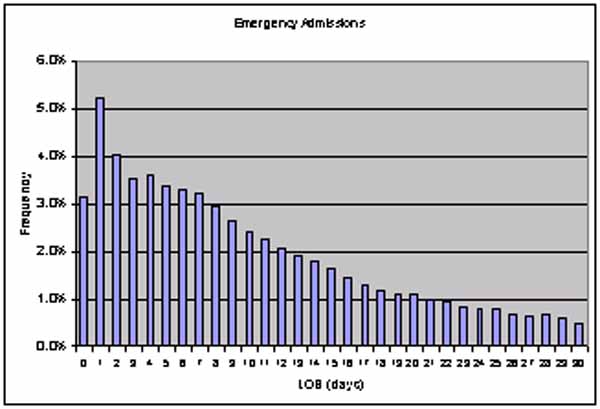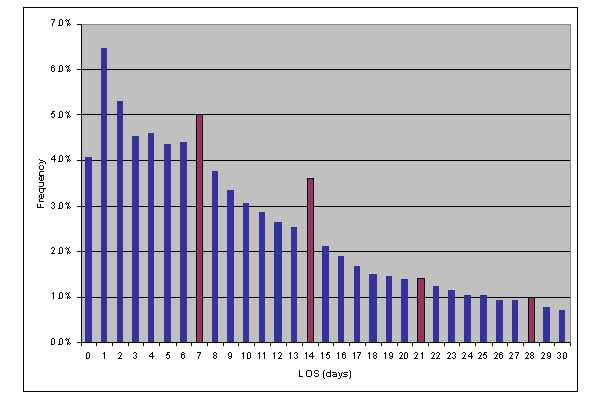Nosokinetics
First Issue in 2005
(c)Authors for content; Peter Millard, Roy Johnston for e-version
(comments to rjtechne at iol dot ie)I am here implementing, in the context of this IMS sponsored web-site version, an approach to screen-friendly layout for archiving substantive papers from the newsletter. Dated newsletter material is being dropped, while the papers are hotlinked each to its own page. RJ.
Editorial: Modelling change and predicting committed costs of long term care.
GIPS, MIPS and Metaclinicians: Dr Derek Meyer.
Precis: the Internet is a two edged sword. Whereas, Expert Patients implies the constructive use of electronically garnered knowledge, GIPS (Google Informed Patients) misuse the knowledge they gain. Modern computers process millions of instructions per second (MIPS), thousands of facts can now be stored, data mining will change the face of medical research and scholarship. Randomised clinical trials will soon be outmoded, rather medicine will advance as metaclinicians design and interpret total population studies (TPS) based on data gathered in universally available electronic patient records.
Intelligent Technologies for Medical Tutoring: Prof Salem Abdel-Badeeh.
Carl Long asks "Ac = Lv: how does that help me?": Peter Millard.
Carl Long writes: OK. The fundamental equation is Ac = Lv, how does that help me? In our patch we do not have long stay hospital beds, only nursing home beds, and access to these is via social services unless private funding is available. In reconfiguration discussions there is talk of us having sub-acute step down beds and rehabilitation beds. Indeed, chaos theory may be more applicable to our situation!
Reviews: Heuristic solutions, Shipman statistics, What's in a day?
Forthcoming conferences.
Stroke patient LOS, planned and emergency.
Modelling Change: Caveat Emptor; Buyer Beware
The present UK hospital planning cycle generates a lot of heat, but little light. Constant change is the order of the day. The planning model now being used, seeks to solve the problem of bed availability in acute hospitals by preventing social admissions and early transfer of patients to alternative accomodation at St. Elsewhere's or in local authority purchased residential or nursing home care.
Models are only as good as the theory on which they are based. Seeking to understand probability theory I came across Roy Weatherhood's criticism of "a priori models":
'If I am interested in the probability that it will rain tomorrow (h), and I choose to evaluate it on the basis of evidence (e) that the Premier of China loves eggs, Carnap's system will (ideally) give me a definitive number for c(he). If I choose to act on the value, I will break no formal rules of inductive logic, but I will be acting rather foolishly.'(1)
The world population is ageing: like it or not, older people will not go away. Consider the cost per individual placed in long-term care below, and the flaw in the current model becomes clear.
Thierry Chaussalet's group(2) has developed a generic model for predicting the committed long-term care cost for current residents. Using data provided by the Social Service Department of the London Borough of Merton, the survival model estimates, on a seven year horizon, that residential care costs £56,000 per person placed and nursing home care costs £42,000, i.e. residential care costs 33% more.
In London (2001 data) the gross weekly cost of residential care was £364 a week, nursing home £511. On April 1st 2001, Merton had 372 older people in care: 217 residential, 155 in nursing. Over a seven-year horizon the total committed cost of care for this cohort is £24 million (se £1.04 million.). In "Penny Wise, Pound Foolish" the significance of these findings is discussed.
A user interface is being developed with Peter Crowther in the Social Services and Housing Department of the London Borough of Merton(3).
Notes and References
1. The quote comes from Weatherford, R. (1982). Philosophical Foundations of Probability Theory. RKP, London p 110. Rudolf Carnap (1891-1970) extended John Maynard Keynes (1883-1946) approach to a priori theories of probability.2. A framework for predicting gross institutional long-term care costs from known commitments at local authority level; Pelletier, C, Chaussalet, T & Xie, H (2005); JORS 56, 144-152.
3. For the mathematics underpinning the model see: Xie, H, Chaussalet, TJ & Millard, PH (2005). A continuous-time Markov model for the length of stay of elderly people in institutional long-term care. Journal of the Royal Statistical Society Series A: Statistics in Society 168, 51-61.
Patients are a virtue: get them if you can:
Using industrial processes to improve patient care:
Shipman's statistical legacy;
An overview of heuristic solution methods.
Health care modelling - why should we try?
Health care modelling: opening the 'black-box'.
Mathematical modelling: how and why.
Local authority fines: penny wise, pound foolish.
Young OR, Bath? April 4th to 6th, 2005:
25th Applied Statistics in Ireland Conference, Enniskillen, 18th-20th May 2005.
IFORS Hawaii? July 11-15, 2005: Website.
The First East European Conference on Health Care Modelling and Computation (HCMC 2005);
OR Society Conference, University College Chester, 13th - 15th September 2005.
Reviews
What's in a day? Determining intensive care unit length of stay;
Marik, PE and L Hedman (2000), Critical Care Medicine 28(6): 2090-3.
Length of stay (LOS) was calculated using four common methods: a) number of calendar days (LOS-calendar); b) midnight bed-occupancy days (LOS-midnight); c) exact LOS calculated in hours divided by 24 (LOS-exact); and d) the method described by Pollack and Ruttimann (LOS-Pollack). There was a poor correlation among the LOS-exact, log LOS-exact, LOS-exact of survivors, and LOS-exact below upper 95th percentile with the APACHE II and APACHE III scores: these scores are predictive of outcome, but should not be used to predict or adjust for LOS. Furthermore, because the LOS distribution is highly skewed, the geometric mean and median should be reported.
An article in a Baltimore business journal describes how appointing hospitalists and software investment for bed availability shortened A&E waiting time and increased admissions by 7%.
Young, T, S Brailsford et al (2004). British Medical Journal 328: 162-164.
Describes three established industrial approaches — lean thinking, theory of constraints and six sigma, and explores how the concepts underlying each might relate to health care.
Spiegelhalter, D and N Best (2004). Significance 1 (March): 10-12.
Reviews statistical aspects of Shipman murders: 215 confirmed, 45 probable. Concludes, if we are not careful, even individuals whose performance is entirely as expected will eventually look odd, just by chance. Risk adjusted cumulative sum: "..(CUSUM) Alarm thresholds balance the probabilities of false and successful detection of a single GP over time. Theoretically, Shipman could have been detected in 1985 at the 65th death", but deaths by GPs are not collected. Methods are simply a "screening tool", indicating the need for further investigation.
Silver, EA (2004). Journal of the Operational Research Society 55: 936-956.
Written for operational researchers and managers interested in the use of mathematical models to aid decision making. Given a mathematical representation of a perceived problem, the paper focuses on the different ways that models can be used to find a solution. Each method discussed is referenced and guidelines are given.
Papers on the web
Good news: Thanks to Andy Cowper, Editor of the British Journal of Health Care Management, four explanatory papers are on the website, in pdf format.
Ivatts, S and P Millard (2002). British Journal of Health Care Management 8(6): 212-216.
Ivatts, S and P Millard (2002). British Journal of Health Care Management 8(7): 251-255.
Harrison, G, P Millard, et al (2003); British Journal of Health Care Management 9(4): 144-150.
Millard, P (2004); British Journal of Health Care Management 10(12): 366-370.
Forthcoming conferences:
See also http://www2.wmin.ac.uk/coiec/nosokinetics.htm
Further details or abstract submission contact Adele Marshall or submit at Website.
Abstracts due 31st March 2005. Contact Adele Marshall.
Craiova, ROMANIA , 31 August to 2nd of September 2005;
paper submission deadline 10 May; Website http://farmath.umfcv.ro/hcmc2005/dates.html
Papers would be most welcome for the Health Stream. Please send titles and abstracts to either Chris Sherlaw-Johnson (c.sherlaw-johnson@ucl.ac.uk) or Gillian Mould (g.i.mould@stir.ac.uk).
Stroke Patient LOS
Factors influencing hospital length of stay of elderly patients with stroke illness; an
Erich Teichmann MSC project. 

Note the influence of seven day and fourteen day discharges of non-emergency admissions on the pattern of length of stay: holiday beds?
We are indebted to IMS MAXIMS plc's sponsorship for enabling the website version to be developed. IMS is a significant supplier to NHS and has an ongoing interest in enhancing the scope of IT support in the NHS, especially in the areas of clinical knowledge and decision support. Developers of systems looking for market opportunities are invited to contact IMS at their UK office, or by e-mail to Paul Cooper (pcooper at imsmaxims dot com). Accessing their web-site http://www.imsmaxims.com will give a feel for the scope of their work.
Some navigational notes:
A highlighted number may bring up a footnote or a reference. A highlighted word hotlinks to another document (chapter, appendix, table of contents, whatever). In general, if you click on the 'Back' button it will bring to to the point of departure in the document from which you came.Copyright (c)Roy Johnston, Peter Millard, 2005, for e-version; content is author's copyright,